Related Research Articles

David Baltimore is an American biologist, university administrator, and 1975 Nobel laureate in Physiology or Medicine. He is a professor of biology at the California Institute of Technology (Caltech), where he served as president from 1997 to 2006. He founded the Whitehead Institute and directed it from 1982 to 1990. In 2008, he served as president of the American Association for the Advancement of Science.
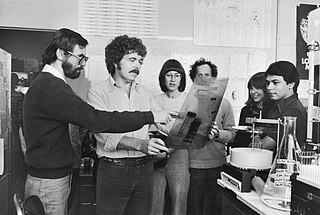
Herbert Wayne "Herb" Boyer is an American biotechnologist, researcher and entrepreneur in biotechnology. Along with Stanley N. Cohen and Paul Berg, he discovered recombinant DNA, a method to coax bacteria into producing foreign proteins, which aided in jump-starting the field of genetic engineering.

Chinese hamster ovary (CHO) cells are a family of immortalized cell lines derived from epithelial cells of the ovary of the Chinese hamster, often used in biological and medical research and commercially in the production of recombinant therapeutic proteins. They have found wide use in studies of genetics, toxicity screening, nutrition and gene expression, and particularly since the 1980s to express recombinant proteins. CHO cells are the most commonly used mammalian hosts for industrial production of recombinant protein therapeutics.

SV40 is an abbreviation for simian vacuolating virus 40 or simian virus 40, a polyomavirus that is found in both monkeys and humans. Like other polyomaviruses, SV40 is a DNA virus that is found to cause tumors in animals, but most often persists as a latent infection. SV40 has been widely studied as a model eukaryotic virus, leading to many early discoveries in eukaryotic DNA replication and transcription.

William French Anderson is an American physician, geneticist and molecular biologist. He is known as the "father of gene therapy". He graduated from Harvard College in 1958, Trinity College, Cambridge University (England) in 1960, and from Harvard Medical School in 1963. In 1990 he was the first person to succeed in carrying out gene therapy by treating a 4-year-old girl suffering from severe combined immunodeficiency.
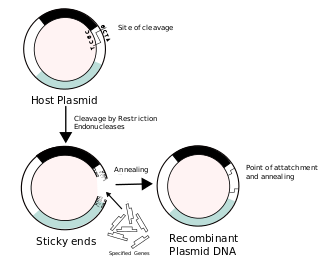
Recombinant DNA (rDNA) molecules are DNA molecules formed by laboratory methods of genetic recombination that bring together genetic material from multiple sources, creating sequences that would not otherwise be found in the genome.
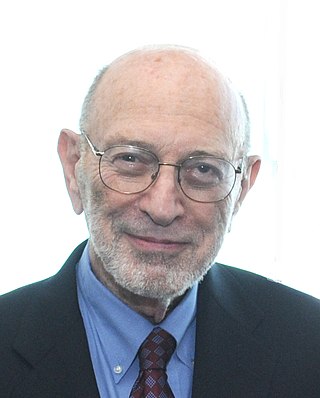
Stanley Norman Cohen is an American geneticist and the Kwoh-Ting Li Professor in the Stanford University School of Medicine. Stanley Cohen and Herbert Boyer were the first scientists to transplant genes from one living organism to another, a fundamental discovery for genetical engineering. Thousands of products have been developed on the basis of their work, including human growth hormone and hepatitis B vaccine. According to immunologist Hugh McDevitt, "Cohen's DNA cloning technology has helped biologists in virtually every field". Without it, "the face of biomedicine and biotechnology would look totally different." Boyer cofounded Genentech in 1976 based on their work together, but Cohen was a consultant for Cetus Corporation and declined to join. In 2022, Cohen was found guilty of having committed fraud in misleading investors into a biotechnology company he founded in 2016, and paid $29 million in damages.
Tom Maniatis, is an American professor of molecular and cellular biology. He is a professor at Columbia University, and serves as the Scientific Director and CEO of the New York Genome Center.
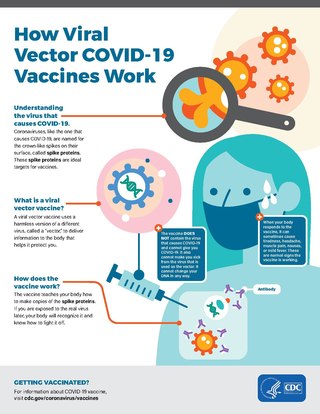
Viral vectors are modified viruses designed to deliver genetic material into cells. This process can be performed inside an organism or in cell culture. Viral vectors have widespread applications in basic research, agriculture, and medicine.
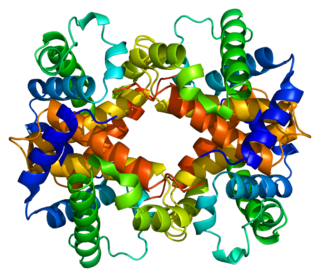
Hemoglobin subunit beta is a globin protein, coded for by the HBB gene, which along with alpha globin (HBA), makes up the most common form of haemoglobin in adult humans, hemoglobin A (HbA). It is 147 amino acids long and has a molecular weight of 15,867 Da. Normal adult human HbA is a heterotetramer consisting of two alpha chains and two beta chains.

Krueppel-like factor 1 is a protein that in humans is encoded by the KLF1 gene. The gene for KLF1 is on the human chromosome 19 and on mouse chromosome 8. Krueppel-like factor 1 is a transcription factor that is necessary for the proper maturation of erythroid cells.

Alpha-globin transcription factor CP2 is a protein that in humans is encoded by the TFCP2 gene.

A genetically modified virus is a virus that has been altered or generated using biotechnology methods, and remains capable of infection. Genetic modification involves the directed insertion, deletion, artificial synthesis or change of nucleotide bases in viral genomes. Genetically modified viruses are mostly generated by the insertion of foreign genes intro viral genomes for the purposes of biomedical, agricultural, bio-control, or technological objectives. The terms genetically modified virus and genetically engineered virus are used synonymously.

Molecular cloning is a set of experimental methods in molecular biology that are used to assemble recombinant DNA molecules and to direct their replication within host organisms. The use of the word cloning refers to the fact that the method involves the replication of one molecule to produce a population of cells with identical DNA molecules. Molecular cloning generally uses DNA sequences from two different organisms: the species that is the source of the DNA to be cloned, and the species that will serve as the living host for replication of the recombinant DNA. Molecular cloning methods are central to many contemporary areas of modern biology and medicine.

Richard M. Myers is an American geneticist and biochemist known for his work on the Human Genome Project (HGP). The National Human Genome Research Institute says the HGP “[gave] the world a resource of detailed information about the structure, organization and function of the complete set of human genes.” Myers' genome center, in collaboration with the Joint Genome Institute, contributed more than 10 percent of the data in the project.

Genetic engineering is the science of manipulating genetic material of an organism. The concept of genetic engineering was first proposed by Nikolay Timofeev-Ressovsky in 1934. The first artificial genetic modification accomplished using biotechnology was transgenesis, the process of transferring genes from one organism to another, first accomplished by Herbert Boyer and Stanley Cohen in 1973. It was the result of a series of advancements in techniques that allowed the direct modification of the genome. Important advances included the discovery of restriction enzymes and DNA ligases, the ability to design plasmids and technologies like polymerase chain reaction and sequencing. Transformation of the DNA into a host organism was accomplished with the invention of biolistics, Agrobacterium-mediated recombination and microinjection. The first genetically modified animal was a mouse created in 1974 by Rudolf Jaenisch. In 1976, the technology was commercialised, with the advent of genetically modified bacteria that produced somatostatin, followed by insulin in 1978. In 1983, an antibiotic resistant gene was inserted into tobacco, leading to the first genetically engineered plant. Advances followed that allowed scientists to manipulate and add genes to a variety of different organisms and induce a range of different effects. Plants were first commercialized with virus resistant tobacco released in China in 1992. The first genetically modified food was the Flavr Savr tomato marketed in 1994. By 2010, 29 countries had planted commercialized biotech crops. In 2000 a paper published in Science introduced golden rice, the first food developed with increased nutrient value.

Eric Emil Schadt is an American mathematician and computational biologist. He is founder and former chief executive officer of Sema4, a patient-centered health intelligence company, and dean for precision medicine and Mount Sinai Professor in Predictive Health and Computational Biology at the Icahn School of Medicine at Mount Sinai. He was previously founding director of the Icahn Institute for Genomics and Multiscale Biology and chair of the Department of Genetics and Genomics Sciences at the Icahn School of Medicine at Mount Sinai.
Janet E. Mertz is an American biochemist, molecular biologist, and cancer researcher. She is currently the Elizabeth McCoy Professor of Oncology in the McArdle Laboratory for Cancer Research at the University of Wisconsin–Madison. Mertz is best known for disputing Lawrence Summers' 2005 suggestion that women lack the intrinsic aptitude to excel in mathematics at the highest level and for discovering an easy method for joining DNAs from different species. This latter finding initiated the era of genetic engineering whose ramifications form the basis of modern genetics and the biotechnology industry.
Keiichi Itakura is an organic chemist and a Professor in the Department of Molecular and Cellular Biology at the Beckman Research Institute at City of Hope National Medical Center.
Edward Francis Fritsch is a scientist in the field of molecular biology and cancer immunology.
References
- ↑ "Richard C. Mulligan, Ph.D. | HMS Department of Genetics". genetics.med.harvard.edu. May 2016. Retrieved 2016-06-21.
- ↑ "Harvard BBS PHD Program".
- ↑ "Richard C. Mulligan, Ph.D. - DF/HCC". dfhcc.harvard.edu. Archived from the original on 2015-05-31. Retrieved 2016-06-21.
- ↑ "Richard C. Mulligan". people.forbes.com. Archived from the original on August 4, 2011. Retrieved 2016-06-21.
- ↑ "Richard Mulligan, Ph.D., Head of SanaX" . Retrieved Dec 24, 2024.
- ↑ Mulligan, R. C.; Berg, P. (19 September 1980). "Expression of a Bacterial Gene in Mammalian Cells". Science. 209 (4463): 1422–1427. Bibcode:1980Sci...209.1422M. doi:10.1126/science.6251549. PMID 6251549.
- ↑ Mulligan, Richard C.; Howard, Bruce H.; Berg, Paul (January 1979). "Synthesis of rabbit β-globin in cultured monkey kidney cells following infection with a SV40 β-globin recombinant genome". Nature. 277 (5692): 108–114. Bibcode:1979Natur.277..108M. doi:10.1038/277108a0. PMID 215915. S2CID 4257109.
- ↑ Mulligan, Richard C. (December 2014). "Development of Gene Transfer Technology". Human Gene Therapy. 25 (12): 995–1002. doi:10.1089/hum.2014.2543. PMID 25513845.
- ↑ Dickman, S (1 October 1997). "Richard Mulligan: from skeptic to true believer". Current Biology. 7 (10): R601-2. doi: 10.1016/s0960-9822(06)00308-3 . PMID 9382777. S2CID 9998648.
- ↑ "Denner said to start activist health-care hedge fund". Connecticut Post. 11 April 2013.
- ↑ "Enzon". enzon.com. Retrieved 2016-06-21.
- ↑ "Business Briefing / Biotechnology - latimes". Los Angeles Times. 4 June 2009. Retrieved 2016-06-21.
- ↑ Writer, GEN Staff (3 March 2017). "Icahn Names Gene Transfer Pioneer as Portfolio Manager". GEN - Genetic Engineering and Biotechnology News.
- ↑ "MacArthur Fellows in Genetics" . Retrieved Dec 24, 2024.
- ↑ "Searle Scholars Program : Richard C. Mulligan (1983)". searlescholars.net. Retrieved 2016-06-21.
- ↑ "Mulligan receives new award". MIT News | Massachusetts Institute of Technology. 2 June 1993.